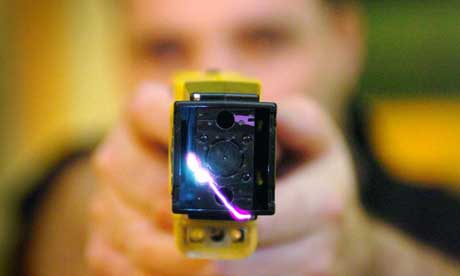After the Argentine government announced the purchase of electrical discharge weapons – known as Tasers – the governments of the city and province of Buenos Aires announced that their police forces will also start bringing them into use. We submitted formal information requests to these three levels of government to understand the assessment driving this decision, the rules and protocols that will serve to guide their use, and the oversight mechanisms that they plan to implement.
Taser stun guns are presented as a “less lethal weapon,” but international experience demonstrates that this categorization leads to their indiscriminate use since officials suppose that they can be used with fewer restrictions than lethal weapons.
Tasers only reduce police lethality if they are used in the same cases in which a lethal weapon would be used, not if their supposed “non-lethality” enables expanding the situations in which police can shoot at people. For example, a study carried out by Amnesty International in the United States showed that of the 334 people killed due to the use of Tasers between 2000 and 2007, only 33 were carrying weapons – and only 4 of those were firearms. This means that more than 90% of the fatal victims were unarmed. The American Civil Liberties Union (ACLU) also warned of the risks arising from the fact that US police forces are no longer using Tasers to replace lethal weapons in situations of last resort, but rather as an instrument of control. This form of using “less lethal” weapons has caused deaths to multiply. Investigations carried out in the United States recorded at least 1,000 cases of deaths due to the inappropriate use of the guns between 2000 and 2017.
These investigations led to the creation of standards and recommendations for utilizing these weapons:
*Tasers, just like lethal weapons, should be used exclusively in extreme situations where there is a real and immediate threat to life or risk of serious injury, as a substitute for lethal weapons. A Taser should not be used without having tried first to avoid using force, through calling out or gesturing to people to stop or using other verbal techniques to subdue them.
*Officials should use a model of Tasers that allows for limiting the length of the discharge to five seconds. If the discharge exceeds 15 seconds, the risk of death increases significantly – a possibility that some models permit.
*Most of the deaths related to the use of Tasers do not occur at the time of discharge, but rather later on due to cardiac arrests or injuries upon falling, among other potential health problems. Their use requires a special procedure for immediate medical examination of people subjected to a discharge.
*The UN Committee against Torture sustains that weapons of this kind must be considered inadmissible as part of the equipment used by guards in prisons or any other place of deprivation of liberty, given that they can be used as instruments of torture since they do not leave visible marks.
Tasers cannot be used in any circumstances against:
*Pregnant people.
*People who appear to be intoxicated with alcohol or drugs.
*People with mental illness.
*People who are already arrested or handcuffed with metal or plastic restraints.
*People who already received a discharge (the same person cannot receive two discharges).
*People who were also subjected to pepper gas. An investigation by the UK Home Office confirmed that the application of an electrical discharge with a Taser can produce a potentially fatal chemical combustion on those who have been sprayed with teargas or pepper gas.
*In addition, Tasers should never be shot at a person’s face, because they can cause blindness if they affect the eyes.
On top of adequate training, the use of Tasers requires health facilities and follow-up and oversight mechanisms that none of the Argentine police forces have at this time.
Some Taser models have mechanisms that record the shots fired, which can be useful for controlling police actions. However, for that technological innovation to work, the political will must exist to control the use of force and investigate each and every situation in which weapons of any kind are used.
In a context in which the Argentine government seeks to weaken oversight of police action and expand the number of situations in which they can use their weapons, it wouldn’t seem that the conditions exist for Tasers to become a tool that reduces lethality. Before discussing the incorporation of more weapons, the comprehensive model of the use of police force should be debated. Under a model that promotes the excessive use of force, any weapon can be a problem, even those that are “less lethal.”

